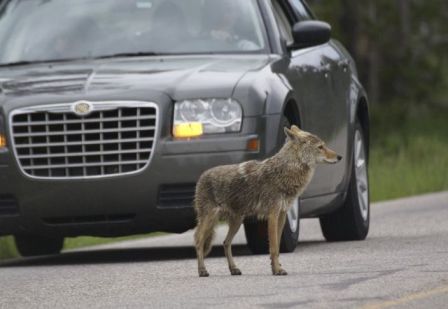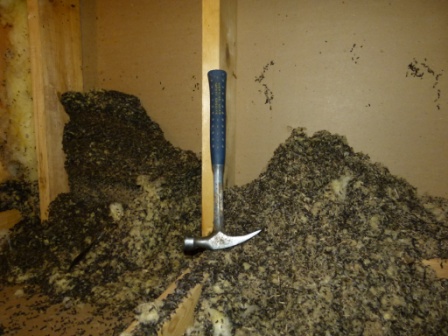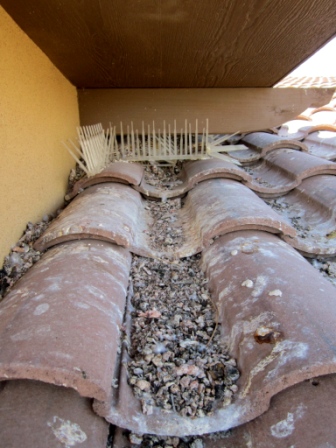
Wildlife control operators walk
the thorny terrain between
protecting animals and killing them
IT’S NOT JUST CORRALES, OR EVEN THE WEST. Coyotes are everywhere these days — in the suburbs, along the coasts, ambling across the Golden Gate Bridge, giving cops a chase in lower Manhattan. They have joined raccoons, squirrels, gophers, rats, and pigeons as animals adaptable enough to coexist with populations of humans who passionately wish them dead.
But it’s one thing for a homeowner to confront the burrowing, chewing, pooping pests that are a perennial pain. When a large predator like the coyote joins the pack, humans’ natural fear and confusion about wild animals leads to some strange reactions. Today’s teary-eyed animal-lover might turn into a wildeyed gunslinger tomorrow after a coyote growls at the family dog. Or tears a head off the family chicken.
Nonviolent souls take to the other extreme, calling on the nearest government agency to cart the offending creature off to some distant wilderness, which is a more delicate but no kinder way of getting it out of sight and mind. And then there are those misguided souls who appreciate the neighborhood fauna so much that they actually leave out food and water — and turn out to be the animals’ worst enemies of all.
When modern homeowners take on nature, in other words, their first instincts rarely solve the problem and often make it worse — just as with gardeners. Extermination, though satisfying vengeance, usually does not work well or long. Wildlife biologists often cite the statistic that you would have to eliminate 70 to 80 percent of the coyote population to make a dent in their numbers, since they respond to being shot or trapped by having more and larger litters, and their absence just invites coyotes from the surrounding country to move in. And coyotes are everywhere these days.
Extermination can also have unwanted consequences, like a sudden influx of rats, or enough foxes to threaten the local songbirds. After all, coyotes became a problem thanks to an earlier extermination campaign, the one that eliminated the wolf.
Moving animals elsewhere may seem like a kinder approach, but wildlife experts grow hoarse explaining that it can actually be more cruel. “The animals are usually put in a habitat that is already filled with animals of that species, and so they have to compete for resources that may already be stretched to the limit because of environmental conditions such as drought,” says Kerrin Grant, wildlife care director at The Wildlife Center in Espanola, where a number of coyote pups from Corrales have been sent.
The problem is the same in the growing suburbs of Nairobi, Kenya, where threatened African lions have been wandering into neighborhoods, killing pets. A biologist notes in a Sept. 11 New York Times report that relocating a lion “kills it slowly and cruelly, but out of sight.” Euthanasia, the lion experts claim, would be kinder.
“Humanely” trapping your common house mouse has similar drawbacks. “Studies show that most wildlife that is relocated does poorly in a new environment,” says local wildlife biologist Justin Stevenson. Especially if it turns out the animal left behind a litter of babies. Now what?
As humans clear more land for homes on mountain and mesa, and wild sources of food become more scarce, conflicts with wildlife have multiplied and spread, spurring the growth of what are variously called wildlife control, nuisance wildlife control, and wildlife damage control operators. In Albuquerque, Stevenson and his wife Holly Smith started RD Wildlife Management earlier this year, leaving their careers in government to consult on problems from bats in the belfry to an attic full of pigeon droppings.
Stevenson believes that most human-wildlife conflicts are exacerbated by a lack of knowledge leading to warped perspectives (and encouraged by sensationalist programs like Infested! and Billy the Exterminator). The impulse to reach for a quick fix — which some pest-control companies and manufacturers are only too happy to provide — just guarantees the homeowner is going to keep on paying and searching.
“Many homeowners will try everything on their own before asking anyone, when we could have seen right away that something wouldn’t work,” Stevenson says. He and Smith offer advice by phone at no cost, and when they don’t hear back, “we know that they’re planning to take care of the problem themselves.” T hey encourage people to “do the right thing,” meaning effective, humane approaches that emphasize exclusion (keeping critters out). “We try to be straight down the middle and follow science,” says Stevenson. But that doesn’t always jibe with human emotional needs.
“People are uncomfortable knowing they are still in the neighborhood,” he says, offering snakes as a prime example. “You don’t solve the problem by moving them somewhere else, but it’s hard to strike a balance with people.”
He and Smith lean toward ecologically sound, preventive solutions, but may end up killing pests if there is no other way to save a home, farm, or garden — and the animal itself is nowhere near endangered.
“People’s perspectives on wildlife change depending on their circumstances,” notes Stephen Vantassel, project coordinator for Wildlife Damage Management (icwdm.org), a research and information site. Animal-loving urbanites may oppose eradication of beavers flooding out a farmer’s crop, he says, but then you have to ask them,“Why are you stopping the shoplifter? He just wants something to eat!” Vantassel reasons.
WILDLIFE DAMAGE MANAGEME NT differs from conventional pest control not only because it focuses on animals instead of insects, notes Vantassel, but because operators do not use pesticides and toxicants, which generally require some form of state licensing. States regulate pest control much more heavily than the relatively small field of wildlife damage control, so operators in many states run the gamut of philosophies about how to deal with troublesome critters.
Made up mostly of sole operators and mom-and-pops, wildlife control approaches also vary greatly with each situation. “A good operator will determine how to reduce damage to a tolerable level, not just go for a body count,” Vantassel says. That generally means some combination of trapping, removal, and exclusion.
The key, says Stevenson, is figuring out how and when to remove, how and when to exclude. RD Wildlife Management uses techniques like professional-grade netting, bird wire, solar-powered repellents, and traps fitted with cameras. These solutions may take time and money, but they aim to be more effective over the long run than removal alone.
“With bats, raccoons, skunks, exclusion is very effective,” Stevenson says. But outdoors, exclusion is often impossible. “I don’t lie to people,” he says. “If you have pocket gophers chewing up roots and destroying trees, we can remove them, but we’ll have to come back and do it several times a year.”
When it comes to coyotes, problems tend to be highly situational. Nationwide, reports of attacks are far more frequent during pup season (spring to summer), when adults are protecting dens or hunting for food. Corrales animal control officer P. “Frosty” Frostenson says specific, aggressive coyotes have been trapped in the past, but he disputes the idea that high coyote numbers are to blame for predation in the Village. “Experts agree there is a sustainable level based on available food,” he says, which in Corrales has remained fairly constant: an adult population ranging from 60 to 120 adults.
Public education, exclusion, and avoidance are the primary techniques adopted likewise in Toronto and Atlanta this year, where controversy flared after coyote attacks. This tends to be the approach recommended by experts to municipal governments as most effective and affordable.
Stevenson relates a recent situation in which the Village of Los Ranchos consulted him about a coyote with severe mange that was preying on geese. Rather than go shoot the coyote — which is illegal in most residential areas, not to mention alarmingly unpopular with residents — he set a trap with a camera, then quickly went and euthanized the coyote in the morning.
BUCOLIC NEIGHBORHOODS like Los Ranchos and Corrales, whose high land values reflect the premium placed on living close to nature, unwittingly invite wildlife problems by maintaining suitable habitat right nearby: the bosque and mesa. In cities, too, humans have been adept at creating habitat for species like raccoons and pigeons. “The vast majority of nuisance species, urbanization has given them homes, not taken them away,” says Vantassel. “All the food we waste — who do you think eats that?”
Humans also invite problems by providing food, intentionally or not. In Toronto the coyote problem in certain neighborhoods was traced to ladies leaving out chicken and rice for the animals. Cat food left outside — as well as cats — can also give individual coyotes a taste for something that might turn to the nearest alternative if frustrated. “People want fairy-tale solutions,” says Vantassel. “There’s so many mythologies the public has about wildlife control.”
He likens relocation of problem animals to airlifting your annoying neighbor 200 miles away and dumping him in the Nevada desert. “How humane is that?” Animal-lovers disparage hunters, he adds, but turn around and pay a wildlife control operator to do the same thing. “The challenge is getting people past the notion that every individual animal is sacred,” he says. “I’m more interested in the viability of the species.”
Stevenson echoes the frustration. While the field has come a long way from its origins in trapping and shooting, preservationists pose their own set of obstacles to coexistence with wildlife. “Our struggle is teaching them that there are real issues,” he says. “You do have to disclose problems when you sell or rent; animals can create health issues and expensive damage, falling home values.” That may not bother one homeowner, but what about his neighbors?
“You will never match people’s ethics 100 percent,” Stevenson adds. And since much of the job involves managing people’s expectations, wildlife damage control will never be lucrative enough to draw heavy investment in research and technology. RD Wildlife Management devotes considerable time and energy to educating lawmakers and the public — which may help their success rate eventually, but not their paychecks.
Successful community wildlife management, says Stevenson, consists of getting people to sit at the same table and look for common ground. “But I have to stay grounded in reality,” he adds. “If you don’t do some kind of wildlife control, you will fail at wildlife management.”


An attic where bats left guano for several years, a foot thick in places. Their urine can permeate the building so that insulation has to be removed. Right: Spikes are commonly installed by homeowners as a pigeon deterrent, but the pigeons have instead used them to anchor nesting materials. Photos courtesy RD Wildlife Management
